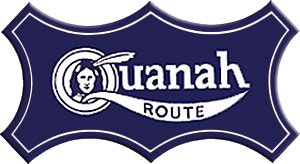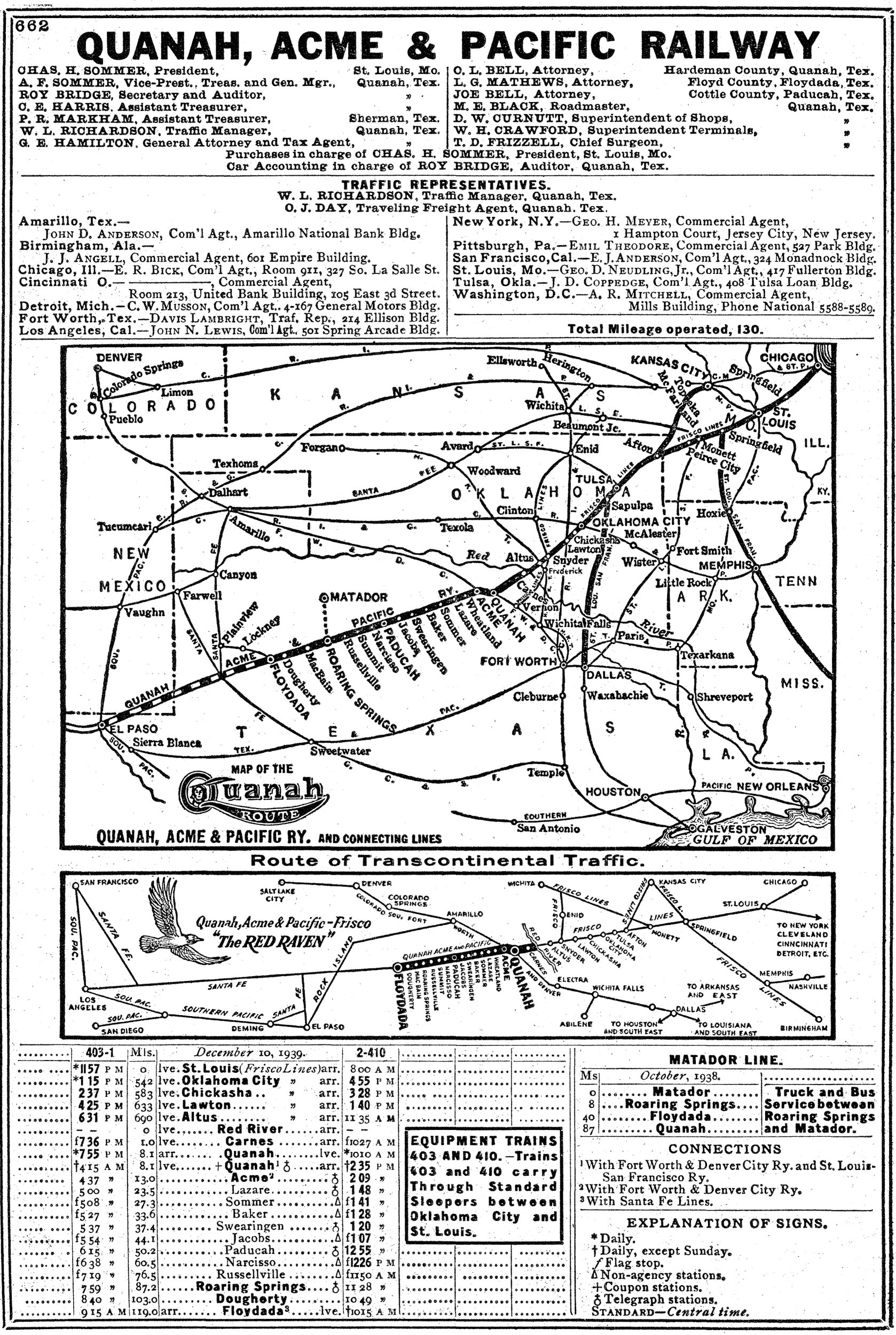Quanah, Acme & Pacific Railway: "The Quanah Route"
Last revised: September 4, 2024
By: Adam Burns
The Quanah, Acme & Pacific Railway (reporting marks, QAP), also sometimes referred to as The Quanah Route for its bridge status began as a system by
another name in the very early 20th century to serve northern Texas.
A few years later it was renamed as the QA&P and had much more grand aspirations to begin pushing west. It was around this time that it was acquired by the St. Louis-San Francisco Railway and operated as an independent subsidiary line for the rest of its days.
While the railroad's "Pacific" hopes were never realized it was able to maintain a level of profitability for many years as a bridge line mentioned above, moving freight along its entire route that stretched roughly 100 miles.
After the Frisco was acquired by Burlington Northern in 1980 so was the QA&P. Unfortunately, its lines were seen as a superfluous to the much larger BN and most of the railroad is abandoned today.
History
The history of the Quanah, Acme and Pacific Railway begins on May 3, 1902 when the Acme, Red River & Northern Railway was chartered by Sam Lazarus.
It was more of less a local system to serve the area's Acme Plaster Company just west of the Red River (its full charter, however, stipulated that it was to connect to Floydada).
Lazarus, who owned the plaster plant, changed his plans for his small railroad a few years later when he renamed it as the Quanah, Acme & Pacific on January 28, 1909 with plans for westward expansion.
He saw the QA&P not so much as a true transcontinental railroad stretching to the Pacific Ocean but as a very long bridge line that would connect to the Southern Pacific's transcontinental "Sunset Route" at El Paso.
Along the way it would connect with other major western carries like the Atchison, Topeka & Santa Fe and funnel east-west traffic between the Midwest (to the St. Louis Gateway via the Frisco) and Southwest.
He also hoped to capture other freight such as cattle and general livestock considering the region's prolific ranching industry.
By 1910 the QA&P had reached Paducah, 35 miles west of Acme although just a year later the Frisco purchased a 100% ownership stake in the company.
Despite this its independence remained separate from its parent, which included Lazarus as president of the property, and it continued to look westward.
Reaching Floydada took much longer than expected, however. After a lengthy court battle with the AT&SF to open a western gateway there the QA&P had a through route of 117.0 miles between Red River, and a connection with the Frisco, to Floydada by 1928.
At Quanah and Acme it also had interchanges with the Fort Worth & Denver Railway owned by the Chicago, Burlington & Quincy.
System Map
Two years prior in 1926 the QA&P had taken over the Motley County Railroad, a short line running from a connection at Matador Junction to Matador.
This road had struggled as an independent and did no better under Quanah's control forcing its abandonment by 1936. Interestingly, while the QA&P would never reach El Paso it continued to label its system maps with the unfinished grade west of Floydada as late as 1944!
Had it done so the railroad would have stretched roughly 500 miles in length and likely been an even more competitive line for transcontinental freight.
In any event, with the bridge traffic it was able to gain from its major Class I connections the Quanah saw a significant increase in revenues.
Essentially, this traffic became so lucrative that the railroad operated time freights to move it as quickly as possible from one interchange to the other.
For instance, these trains were named, and known, by their moniker as either Flash or "Advance 435" and the railroad set them on a strict schedule of just 2 hours and 40 minutes to travel the entire railroad of 117 miles!
These time freights, however, did not make up all of the QA&P's traffic. It also moved a good bit of agricultural traffic including cotton, wheat, and grain.
However, since this was seasonal the railroad did not depend on it as a sustained revenue source.
Additionally, for a time in the 1930s when the streamliner craze was hitting the nation it operated an expedited passenger train known as the Plainsman.
Listed as trains #409 and #410 the QA&P marketed it as a through connection to eastern and western points including St. Louis and Los Angeles with sleeper service offered.
During the steam era the Quanah, Acme And Pacific Railway predominantly relied upon larger 4-4-0 Americans, 4-6-0 Ten Wheelers and even 2-10-0 Decapods to handle freight and passenger chores.
However, a much greater improvement in operations was gained when it acquired a handful of Electro-Motive GP7s beginning in 1951.
The railroad stated that the diesels enabled it to move more freight in one week than it could under steam power in six days. By the 1950s it was running four hotshot freights daily and during 1958 posted an incredible operating ratio of just 45.01%.
Final Years
The end for the QA&P, however, came swiftly and abruptly when the Frisco and Santa Fe decided to switch their interchanging routing in the fall of 1973 that bypassed the railroad.
With the loss of lucrative bridge traffic the railroad struggled to survive. It became part of BN in 1980 after its parent sold out to the large western giant that year.
Soon after, with little need for The Quanah Route BN abandoned much of the line west of Quanah that constituted roughly 100 miles. Today, only 5 miles remains between Acme to Quanah, still owned by successor BNSF Railway.
(Thanks to Donald Sims' "Quanah Means Quick" from the February, 1962 issue of Trains as a primary reference for this article.)
Recent Articles
-
Montana Dinner Train Rides Near Lewistown!
Jan 08, 26 03:03 PM
The Charlie Russell Chew Choo turns an ordinary rail trip into an evening event: scenery, storytelling, live entertainment, and a hearty dinner served as the train rumbles across trestles and into a t… -
Alabama's - Murder Mystery - Dinner Train Rides
Jan 08, 26 02:19 PM
There is currently one location in the state offering a murder mystery dinner experience, the Wales West Light Railway! -
Rhode Island's - Murder Mystery - Dinner Train Rides
Jan 08, 26 01:43 PM
Let's dive into the enigmatic world of murder mystery dinner train rides in Rhode Island, where each journey promises excitement, laughter, and a challenge for your inner detective. -
Florida's - Wine Tasting - Train Rides
Jan 08, 26 01:13 PM
Wine by train not only showcases the beauty of Florida's lesser-known regions but also celebrate the growing importance of local wineries and vineyards. -
Texas's - Wine Tasting - Train Rides
Jan 08, 26 12:30 PM
This article invites you on a metaphorical journey through some of these unique wine tasting train experiences in Texas. -
New York's - Wine Tasting - Train Rides
Jan 08, 26 11:32 AM
This article will delve into the history, offerings, and appeal of wine tasting trains in New York, guiding you through a unique experience that combines the romance of the rails with the sophisticati… -
California Dinner Train Rides In Sacramento!
Jan 08, 26 11:21 AM
Just minutes from downtown Sacramento, the River Fox Train has carved out a niche that’s equal parts scenic railroad, social outing, and “pick-your-own-adventure” evening on the rails. -
New Jersey Dinner Train Rides In Woodstown!
Jan 08, 26 10:31 AM
For visitors who love experiences (not just attractions), Woodstown Central’s dinner-and-dining style trains have become a signature offering—especially for couples’ nights out, small friend groups, a… -
Nevada's - Murder Mystery - Dinner Train Rides
Jan 07, 26 02:12 PM
Seamlessly blending the romance of train travel with the allure of a theatrical whodunit, these excursions promise suspense, delight, and an unforgettable journey through Nevada’s heart. -
West Virginia's - Murder Mystery - Dinner Train Rides
Jan 07, 26 02:08 PM
For those looking to combine the allure of a train ride with an engaging whodunit, the murder mystery dinner trains offer a uniquely thrilling experience. -
Kansas's - Murder Mystery - Dinner Train Rides
Jan 07, 26 01:53 PM
Kansas, known for its sprawling wheat fields and rich history, hides a unique gem that promises both intrigue and culinary delight—murder mystery dinner trains. -
Michigan's - Wine Tasting - Train Rides
Jan 07, 26 12:36 PM
In this article, we’ll delve into the world of Michigan’s wine tasting train experiences that cater to both wine connoisseurs and railway aficionados. -
Indiana's - Wine Tasting - Train Rides
Jan 07, 26 12:33 PM
In this article, we'll delve into the experience of wine tasting trains in Indiana, exploring their routes, services, and the rising popularity of this unique adventure. -
South Dakota's - Wine Tasting - Train Rides
Jan 07, 26 12:30 PM
For wine enthusiasts and adventurers alike, South Dakota introduces a novel way to experience its local viticulture: wine tasting aboard the Black Hills Central Railroad. -
Kentucky Thomas The Train Rides
Jan 07, 26 12:26 PM
If you’ve got a Thomas fan in the house, Day Out With Thomas at the Kentucky Railway Museum is one of those “circle it on the calendar” weekends. -
Michigan's Thomas The Train Rides
Jan 07, 26 12:10 PM
If you’ve got a Thomas fan in the house, few spring outings feel as “storybook-real” as Day Out With Thomas™ at Greenfield Village in Dearborn, Michigan. -
Texas Dinner Train Rides On The TSR!
Jan 07, 26 11:36 AM
Today, TSR markets itself as a round-trip, four-hour, 25-mile journey between Palestine and Rusk—an easy day trip (or date-night centerpiece) with just the right amount of history baked in. -
Iowa Dinner Train Rides In Boone!
Jan 07, 26 11:06 AM
If you’ve ever wished you could pair a leisurely rail journey with a proper sit-down meal—white tablecloths, big windows, and countryside rolling by—the Boone & Scenic Valley Railroad & Museum in Boon… -
Wisconsin Dinner Train Rides In North Freedom!
Jan 06, 26 10:18 PM
Featured here is a practical guide to Mid-Continent’s dining train concept—what the experience is like, the kinds of menus the museum has offered, and what to expect when you book. -
Pennsylvania Dinner Train Rides In Boyertown!
Jan 06, 26 06:48 PM
With beautifully restored vintage equipment, carefully curated menus, and theatrical storytelling woven into each trip, the Colebrookdale Railroad offers far more than a simple meal on rails.



















